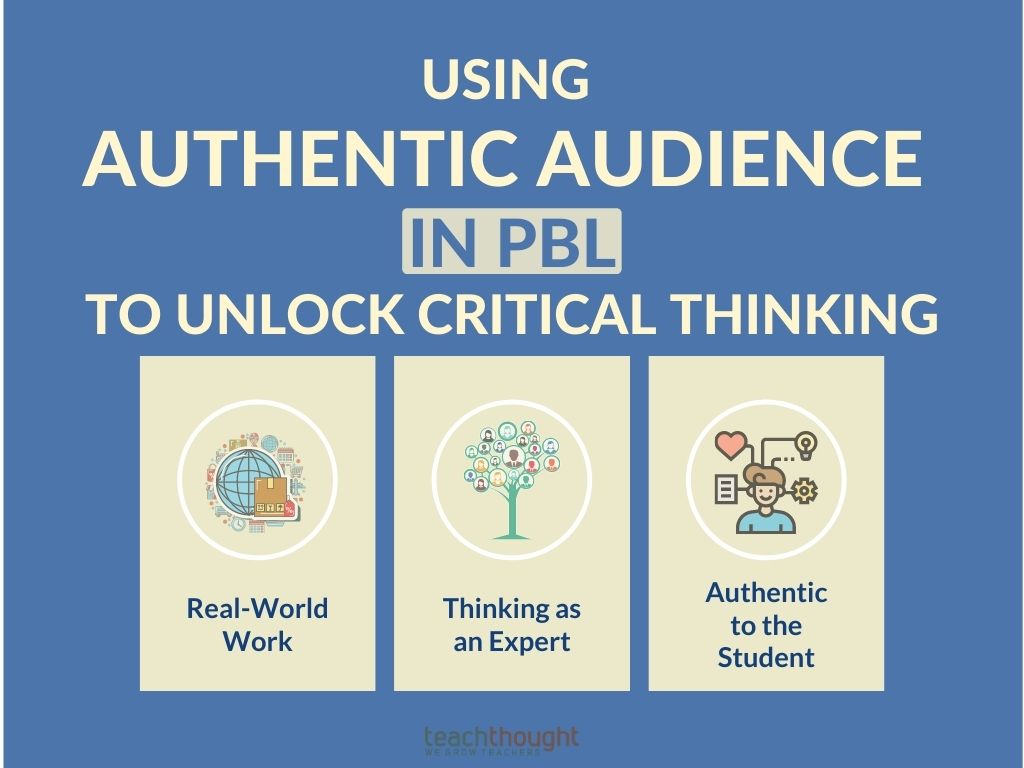
How To Use Authentic Audience In PBL To Unlock Critical Thinking
contributed by Drew Perkins
The TeachThought PBL model includes 5 ‘levers for quality’ that we rely on as we guide educators through the project design process in our workshops and coaching. They’re all important and work together to impact and elevate deeper thinking and learning.
As teachers engage in the early stages of their PBL journey we advocate they focus on developing a practical understanding of what we call Rich Inquiry and its connections to the second lever, Authenticity.
Some PBL models and professional development lean more into the idea of making student products public. That’s good but when we include the element of authenticity in the PBL process it unlocks Rich Inquiry in a way that solely making products public falls short of.
See also 6 Strategies For Creating An Inquiry-Driven Classroom
Authenticity in PBL is often thought of as students solving real-world problems and that can be an intimidating standard for teachers for reasons that are understandable. Before getting to the power of authenticity, here’s what we mean by authenticity.
3 Ways To Include Authenticity In Your PBL
1. Real-World Work
This kind of authenticity includes students working on a real-world problem or creating products for actual clients. For example, perhaps students are creating and administering a water quality testing system for area residents concerned about whether their drinking water is safe. Or perhaps students are building structures for the U.S. Fish and Wildlife Service. No doubt this kind of authenticity can be difficult to achieve, especially in more traditional school settings.
2. Working and Thinking as an Expert in the field
Here we ask students to think and engage with the content in ways that experts working in that academic area or field of expertise would. An example of this is The Wing Project where the teacher asks his students to design and build model airplane wings with the help and feedback from local aeronautical engineers. I certainly don’t want students building wings for any plane I might fly on but I do want them thinking and engaging as engineers which requires substantial academic content knowledge and understanding.
This level of authenticity is much more approachable as most teachers can see ways in which their content applies in the adult world that allows students to think like historians, mathematicians, artists, scientist, author, editor, health service professionals, etc.
3. Authentically Important and Meaningful to the student(s).
In these kinds of projects we see students creating something that they find personally relevant. A very high level example is this high school student creating a sustainable aquaponic system that provides fresh vegetables for the cafeteria. These projects can include high levels of academic content standards but not necessarily. This level of authenticity works best in passion project or genius hour settings where there may not be meaningful academic content standards you’re held accountable for.
While the second level is most common among them some projects can be authentic in all three ways.
The Power Of Authentic Audience
Including an authentic audience for our student creations and products unlocks several pieces of our PBL model. We advocate for clarifying product, as well as audience and purpose both in your project planning and with the students. With an authentic audience, the door opens to the process of Rich Inquiry as they begin asking important questions like:
- Who is our audience?
- What are their needs?
- How do we meet those needs?
- How will we know if we’ve met those needs?
As your project progresses these questions are a great lead-in to two more levers in our PBL Model, Meaningful Assessment and Craftsmanship, as students (and teachers) begin asking if their work is high quality. Instead of this conversation being mostly about points and grades it becomes about evidence and feedback in terms of meeting the needs of the audience. A good fit for this process are single-point rubrics.
Making student products public can certainly increase the level of accountability and sometimes engagement. Adding an authentic audience where students are clear on what purpose their products are serving for their audience can add a powerful layer of inquiry-focused critical thinking.
